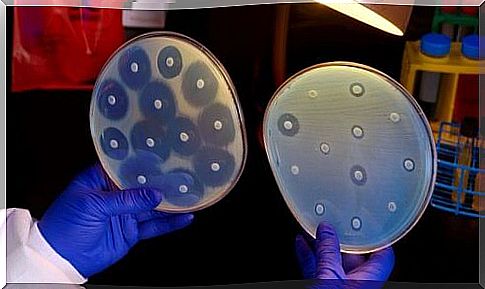What Is Bactroban?
Bactroban is the brand name of an antibiotic ointment whose active substance is mupirocin. Each gram of ointment contains 20 mg of mupirocin, an antibiotic obtained by fermenting Pseudomonas fluorescens .
It is an antibiotic ointment that is active against the vast majority of bacteria that cause skin infections.
How does Bactroban work?
This drug exerts its effect by preventing the bacterial synthesis of proteins, through the inhibition of the isoleucyl-transfer RNA-synthetase enzyme.
Due to its mechanism of action and its chemical structure, it does not produce cross resistance with other antibiotics. Mupirocin is bacteriostatic at minimal inhibitory concentrations and bactericidal at the highest concentrations achieved when applied locally.
What is it indicated for?
Mupirocin is indicated for the treatment of skin infections caused by sensitive microorganisms. Therefore, it is indicated in the treatment of primary skin infections, such as folliculitis, impetigo or furunculosis.
However, it is also prescribed when secondary dermatological infections appear, such as superinfected contact dermatitis, infected wounds, atopic dermatitis and eczematous dermatitis, provided they are of limited extent.
Mupirocin is a topical antibacterial agent that shows in vivo activity against Staphylococcus aureus, S. epidermidis, and ß-hemolytic Streptococcus species .
However, in vitro, the spectrum of their activity includes bacteria such as:
- Staphylococcus aureus and Staphylococcus epidermidis.
- Streptococcal species.
- Haemophilus influenzae.
- Neisseria gonorrhoeae and Neisseria meningitidis.
- Moraxella catarrhalis.
- Pasteurella multocida.
If you have been prescribed Bactroban to treat cracks in the nipple, it is necessary to wash it very well before feeding the baby.
How is Bactroban used?
An application of mupirocin is made 2-3 times a day for 5-10 days, depending on the response. If after 3-5 days of treatment, no improvement is seen, the diagnosis or treatment should be reconsidered.
The first thing to do is wash and dry the area to be treated. Then apply a small amount of ointment and, if necessary, you can cover it with an occlusive bandage or gauze.
It should not be mixed with other ointments, since there is a risk of dilution. This would lead to a decrease in antibacterial activity and consequently to a possible loss of stability of the mupirocin in the ointment.
Adverse reactions and contraindications
The reported adverse reactions that the use of Bactroban may cause were determined based on pooled safety data from a clinical trial population of 1,573 treated patients spanning 12 clinical studies.
With regard to the skin and subcutaneous tissue, localized burning may appear in the area of application. Less commonly, itching, erythema, and stinging may appear. Allergic reactions including anaphylaxis, generalized rash, hives, and angioedema have also been reported.
The use of mupirocin is contraindicated in patients with a history of hypersensitivity to this active principle and to the rest of the components that appear in its formulation.
If you are pregnant or think you could be, due to the lack of information in this regard, mupirocin should not be used in these cases. Also, if you are breastfeeding it should not be used either, as it can pass into the milk and affect the baby.
What should you keep in mind?

Before the appearance of a sensitization reaction or a strong local irritation when using this medicine, you must interrupt the treatment and remove the applied product. As an antibiotic with antibacterial action, its prolonged use can cause a proliferation of non-susceptible organisms.
Patients are unlikely to experience diarrhea during treatment with mupirocin as it is administered topically. However, if the patient experiences prolonged or significant diarrhea or abdominal cramps, the treatment should be stopped and the doctor should be consulted.
Bactroban should not be used when there is evidence of kidney failure. This is because it has macrogol as the base of its formulation and this substance can be absorbed through the injured skin, being subsequently eliminated by the kidneys.
We must be careful not to use it on very large areas of the skin. In case of overdose, there is no specific treatment, although, if it occurs, the patient should receive supportive treatment and, if necessary, it is monitored.
Mupirocin is indicated for the treatment of skin infections caused by sensitive microorganisms. When used, the national recommendations regarding the proper use of antibacterials must be taken into account.









